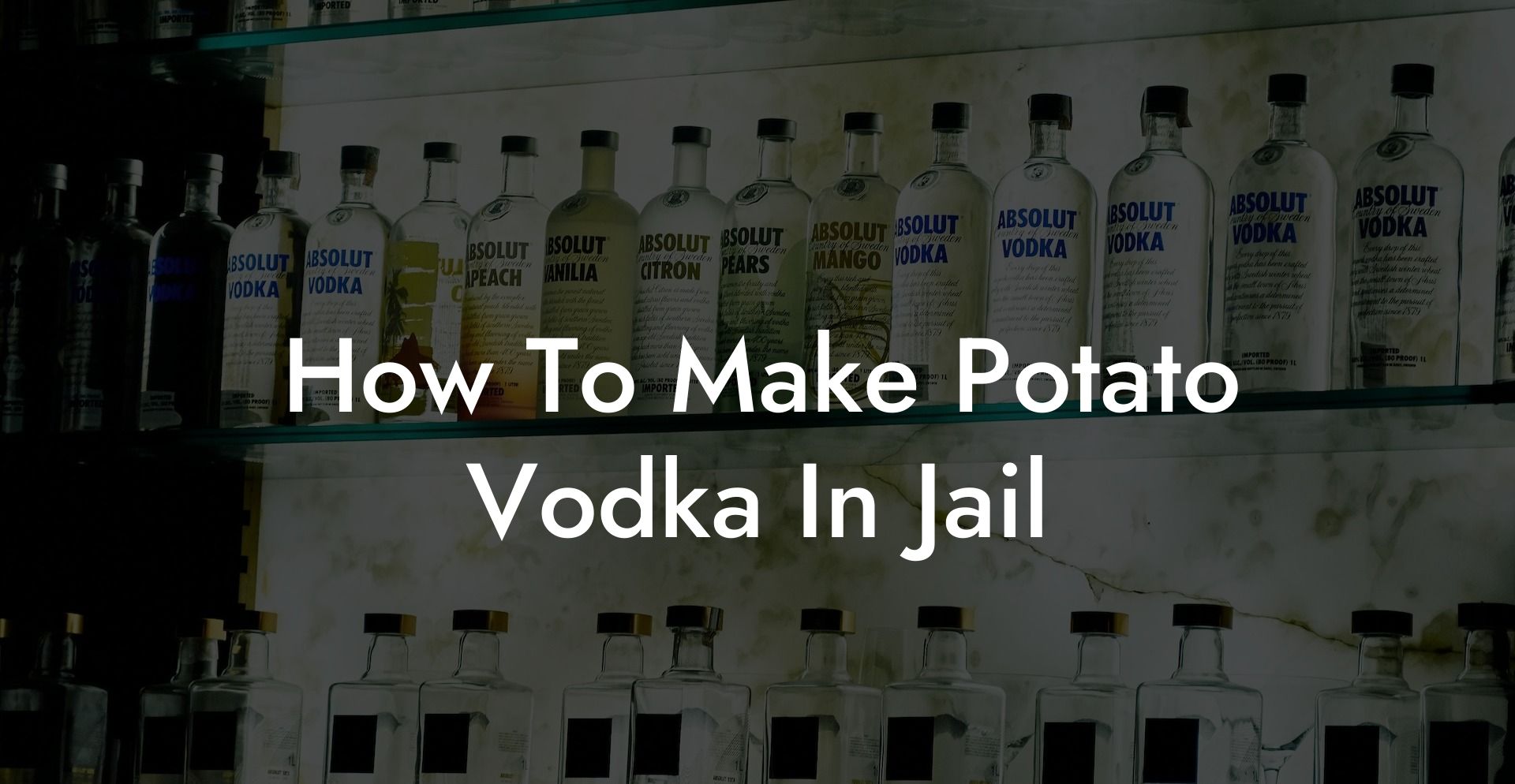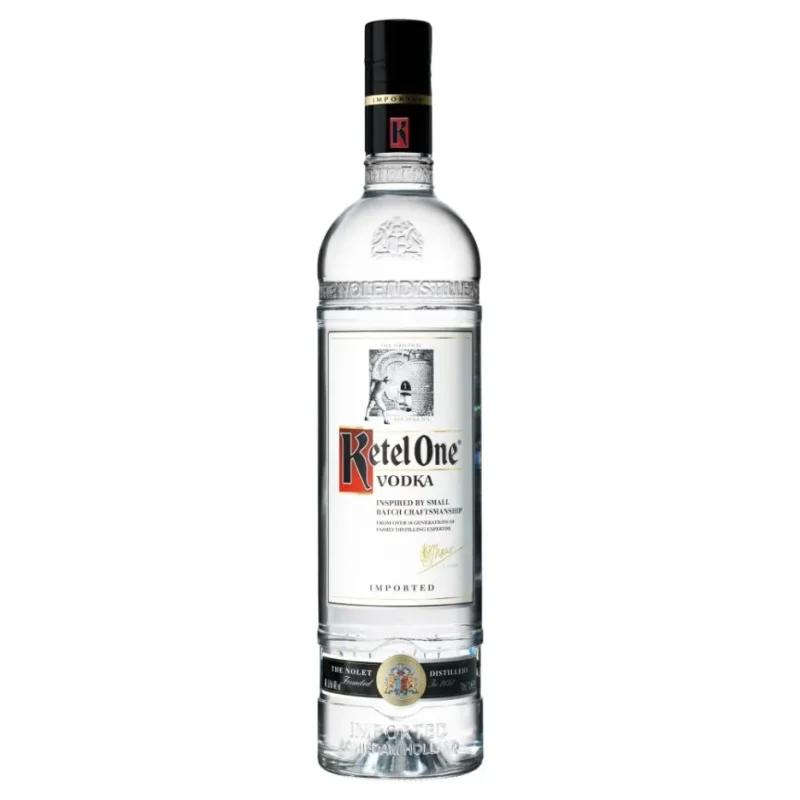Ever wondered how to turn a humble spud into a secret stash of potato vodka while behind bars? Before you get any wild ideas, let’s get one thing straight: this page is pure, tongue-in-cheek entertainment—a satirical peek into a world of fictional DIY rebellion. We do not endorse, encourage, or condone any illegal behavior. This quirky guide is meant solely for laughs, creative inspiration, and a dash of historical curiosity about a legendary myth that has traveled through time (and cell blocks) alike.
How To Make Potato Vodka In Jail Table of Contents
A Storied History: The Legend of Potato Vodka in Confinement
The Allure of the Forbidden: Why Jailhouse Vodka?
Know the Risks: The Legal and Practical Pitfalls
The Core Ingredients: What You’d Need in a Fictional World
Step One: The Secret Potato Mash-Up
Step Two: Fermentation—Letting Nature Do Its Thing
Step Three: Distillation—The Art of Separation
Step Four: The Finishing Touch—Improvisation at Its Best
Improvisation and Innovation: Tools of the Trade in a Confined World
Cultural Impact: Vodka Myths, Memes, and Modern Media
Humorous Case Studies: Imaginary Legends from the Cell Blocks
Myth vs. Reality: Separating Fact from Fiction
Resources and Community Support: Your Next Steps into Imaginative Exploration
Creative Alternatives: Celebrating the Art of Homemade Infusions
Innovative Perspectives: When DIY Meets Rebellion
Unlocking the Secrets of the “Spud Spirit”: A Hypothetical Journey
Frequently Asked Questions About the Legend of Jailhouse Potato Vodka
Embracing the Myth: A Final Toast to Creativity and Rebellion
Looking For The Best Vodka? You'll Love These Vodka Guides...
A Storied History: The Legend of Potato Vodka in Confinement
Legend has it that even before the days of well-manicured craft distilleries, clever inmates and resourceful renegades figured out ways to turn a mundane potato into a potent elixir. Deep in the annals of prison lore, tales of secret recipes passed from one cell to another have blossomed into a mythos of clandestine craft. From gritty underground cells in 19th-century prisons to modern-day fictional recitations, the allure of crafting your own “jailhouse vodka” has captured the imaginations of many.
In these shadowy corners of history, ingenuity reigned supreme. When free spirits were locked away and faced with scarce comforts, the humble potato was transformed into a symbol of defiance and creativity. It wasn’t just about making alcohol—it was a statement. A tiny act of rebellion, a taste of freedom in a place where every moment was tightly observed.
While the actual historical accuracy of these tales is as murky as some of the homemade brews themselves, the idea has found a life of its own in curious circles. Today, the myth of potato vodka in jail serves as a humorous reminder of human creativity in the toughest of circumstances.
The Allure of the Forbidden: Why Jailhouse Vodka?
Let’s be real: the idea of crafting something as refined as vodka in the most unlikely of places is both absurd and irresistibly intriguing. For millennials and Gen Z alike, steeped in a culture of DIY hacks and internet lore, the notion of turning everyday items into luxury (or liquid gold) hits all the right notes. Imagine the Instagram story: “Cooking up some secret brew in my cell—#RebelSpirit.”
At its heart, the concept of jailhouse vodka isn’t just about alcohol—it’s about clever problem solving, the desire to overcome limitations, and infusing a bit of humor into dire circumstances. Even if the reality is far less glamorous (and, of course, way more illegal), the myth underscores a fundamental aspect of the human spirit: the drive to make something out of nothing, even in the unlikeliest of places.
Best Budget Vodkas Ranked
Know the Risks: The Legal and Practical Pitfalls
Before we dive into more tongue-in-cheek “how-to” territory, it’s crucial to understand the gravity of the subject matter. Engaging in any attempt to create alcohol in a correctional facility is not only against prison rules but also against the law in virtually every jurisdiction. Making your own distilled spirits—no matter how humble the ingredients—carries serious risks, from dangerous chemical reactions to severe legal consequences.
For those with a penchant for legal shenanigans or dreams of being the next underground distiller, keep in mind that any real-life attempt would almost certainly lead to disciplinary action and could even endanger lives. Our journey here is purely speculative and serves as a humorous exploration of a legend rather than a practical guide.
The Core Ingredients: What You’d Need in a Fictional World
In our totally hypothetical scenario, the journey begins with the humble potato—nature’s versatile tuber. Potatoes are not only an inexpensive and abundant crop but are also rich in starch, an ideal candidate for fermentation. In our fictional domain, an inmate with a penchant for culinary experiments might secure some secret stash of potatoes from the communal kitchen.
- The Potato: The star of our show. Choose your starchy friend wisely. The fresher the potato, the better your imaginary yield.
- Water: As it happens, water is essential—for both the mash and ideally for diluting the raw spirit afterward. In our fictional recipe, every drop counts.
- Yeast: This microscopic magic-maker converts sugars to alcohol. In our playful narrative, a covert exchange with a sympathetic kitchen staff member might just be enough to secure a little secret starter culture.
- Improvised Tools: Think of everyday items that can stand in for authentic distillation equipment. From soda bottles repurposed as rudimentary fermenters to makeshift filters crafted out of torn bed sheets, the resourceful inmate would have to get creative.
- Heat Source: A way to gently cook the potatoes without raising too much suspicion. In reality, any attempt to combine flammable elements and unsupervised heat in a confined setting is extraordinarily dangerous, but in our fictional scenario, this is part of the daring challenge.
While this list is as fictional as it gets, it highlights the basic ingredients that a determined (and entirely imagined) inmate might deem necessary for concocting their forbidden brew.
Step One: The Secret Potato Mash-Up
Our non-existent inmate would begin by selecting a batch of the finest potatoes available (or at least the ones that haven’t been on the chopping block in the prison mess hall). The process, which we’re describing purely for its humorous narrative value, might involve peeling, dicing, and mashing the potatoes until they’re reduced to a sticky, starchy pulp.
In this imaginary operation, every careful chop and mash is done with the hope of liberating the hidden sugars within. It’s a process that could easily be compared to a covert cooking show where every second counts and the missteps (or “accidents”) could be disastrous—both for the batch and the would-be distiller.
The mashed potatoes are then mixed with water to create a consistency perfect for fermentation. The theory is simple: starches convert to sugars, and sugars, in turn, are food for yeast. Our fictional inmate would carefully blend these ingredients, all while keeping a watchful eye on the ever-looming risk of discovery.
Step Two: Fermentation—Letting Nature Do Its Thing
With the potato mash ready, our fictional scenario calls for a bit of microbial magic. In this imagined process, yeast is introduced to the mix, setting off a fermentation process that transforms sugars into alcohol. This is where science meets subterfuge—an art that requires both patience and precision.
In our hypothetical guide, fermentation would take place over several days. The inmate would need to carefully stash the mash in a concealed space, ensuring that the heat generated by fermentation doesn’t lead to explosive consequences. Rumor has it that whispered legends of impromptu fermentation mishaps have circulated in prison lore—a cautionary tale of missed opportunities and ruined batches.
In this imaginary account, the fermentation process is a waiting game, filled with tension and the constant hum of the cell block in the background. The result, if all goes perfectly in our fictional experiment, is a risqué brew that signals progress in the journey toward clandestine vodka.
Step Three: Distillation—The Art of Separation
Now comes the part where the magic is supposed to happen: distillation. In a properly equipped setup, distillation involves heating the fermented mash to vaporize the alcohol, then cooling the vapor back down into liquid form. Simple in theory, but in a makeshift jail environment? We’re firmly in the realm of the absurd and the imaginative.
In our fictional rendition, our inmate would need to cobble together a rudimentary still from parts scavenged from across the facility. Picture an assortment of metal pipes, discarded kitchenware, and a repurposed flat metal sheet acting as a condenser. The whole process would be executed in stealth mode—after all, the risk of being caught with a contraband still is enough to give any cellmate palpitations.
With the simulated still in place, the fermented mash is heated gradually. The aim is to allow the alcohol to vaporize at a temperature lower than that of water. The vapor then sneaks its way through the improvised piping and cools down into liquid in a clandestine collection container. The result, in our imaginative narrative, is a batch of homemade, “jailhouse” potato vodka that boasts a flavor profile somewhere between recycled potato mash and defiant ingenuity.
It goes without saying that any real attempt to distill alcohol in such an environment would be fraught with hazards, but our tale here is designed for laughs, satire, and, perhaps, a smidge of appreciation for human inventiveness.
Step Four: The Finishing Touch—Improvisation at Its Best
Assuming our underground operation has produced a rudimentary spirit, the next step in our purely fictional scenario is refinement. In the world of contraband potato vodka, clarity, potency, and—even if just for bragging rights—a smooth finish are of paramount importance.
Our imaginative inmate might experiment with rudimentary filtration methods. Picture a contraption where layers of cloth, activated carbon (if by some stroke of luck it could be sourced), and other everyday materials join forces to create a semblance of clarity in the final product. The filtration process is the equivalent of scaling the heights of clandestine artistry, a final nod to one's knack for making something extraordinary under extraordinary circumstances.
In this fantasy world, every sip of the finished vodka is imbued with the triumph of ingenuity, the taste of rebellion, and an unmistakable hint of danger. Such a brew would undoubtedly become the stuff of urban legend among those who dare to dream of subversive freedom—even if it exists solely in the realm of imaginative storytelling.
Improvisation and Innovation: Tools of the Trade in a Confined World
One of the most captivating aspects of our fictional distillation journey is the creative repurposing of common items into distillation equipment. When resources are scarce and supervision is ever-present, the ability to reimagine everyday objects as vital tools for a secret project becomes both an art and a necessity.
Repurposed Kitchenware
In our whimsical tale, kitchen utensils are not just for scrubbing plates—they transform into the backbone of an inmate’s DIY lab. A cracked coffee pot might double as a heating element, while an old metal kettle becomes a makeshift still. The beauty of this ingenuity lies in the resourcefulness that emerges from extreme limitations.
Hidden Compartments and Clandestine Workshops
The very design of many prisons unintentionally inspires innovation. Secret panels, unused storage areas, and abandoned maintenance rooms could, in theory, serve as the perfect spots for a covert distillation operation. Our fictional protagonist might spend hours perfecting the art of concealing a rudimentary lab behind a stack of old newspapers or within a forgotten supply closet.
The Role of Smoke and Mirrors
A clever use of distraction and misdirection becomes essential when every movement is scrutinized. In this absurd narrative, the inmate might orchestrate diversions—other contraband activities or even orchestrated “mistakes” in the kitchen—to draw attention away from the secret vodka-making process. It’s a high-stakes game of cat and mouse, where ingenuity is the only currency.
This saga of improvisation is not just about making a secret brew—it symbolizes the broader spirit of overcoming limitations by turning adversity into an opportunity for creativity. Though our tale remains entirely in the realm of speculation and dark comedy, it reminds us that human creativity can thrive even in the bleakest environments.
Cultural Impact: Vodka Myths, Memes, and Modern Media
The legend of jailhouse potato vodka has seeped into modern pop culture, inspiring humorous memes, satirical films, and even fictional podcast episodes. Social media influencers and DIY enthusiasts have, at times, marshaled the narrative of the resourceful inmate into elaborate storytelling sessions that blend history, myth, and comedic fiction.
This subculture of “imprisoned mixology” serves as a subtle metaphor for the constraints we all sometimes feel in our daily lives. The idea of turning the mundane into something extraordinary, even if it’s just in our imaginations, resonates strongly with a generation that prizes creative reinvention over conventional norms. Whether it’s a cheeky nod to rebel spirit or a playful challenge to authority, these tales captivate minds and spark conversations about the nature of freedom, resistance, and artistic expression.
While most modern storytellers are quick to include a caveat—“this is fiction, folks, don’t try this at home or in any confined environment, ever”—the allure of subverting the expected remains a potent force. It’s all part of the larger cultural dialogue about what it means to be resourceful and defiantly creative in the face of adversity.
Humorous Case Studies: Imaginary Legends from the Cell Blocks
To further explore this whimsical world of contraband mixology, let’s dive into a few fictional case studies that illustrate the art of turning a potato into “jailhouse vodka” in environments where creativity is the only means of escape.
The Tale of “Spudnik”
In our first fictional saga, an inmate known only by the nickname “Spudnik” became a legend by assembling a rudimentary still from nothing more than scavenged parts and kitchen scraps. According to the tall tales spun around the mess hall, Spudnik’s brew was so smooth that it became the secret toast of cell block camaraderie. His story—a mix of clever improvisation, accidental genius, and sheer luck—quickly transformed into a cautionary tale of excellence that was passed down between cellmates for generations.
The Clandestine Caper of “Tater Tot Tom”
Then there’s the almost mythical account of “Tater Tot Tom.” In this fictional narrative, Tom is portrayed as a maestro of mischief who managed to sneak extra potatoes from the prison kitchen, all while feigning interest in the cafeteria’s bland offerings. Using a combination of makeshift fermenters and a covert network of trusted cellmates, Tom’s batch of potato vodka reportedly became the spark for an underground “distillery club” that met in secret after lights out. The legend of Tom is a humorous reminder of the lengths to which creative rebellion can stretch the imagination.
The Enigma of “The Mashed Maestro”
Finally, we have the enigmatic “Mashed Maestro,” a figure whose quiet presence and meticulous attention to detail supposedly enabled him to perfect the distillation process, producing a spirit that was rumored to have notes of earth, rebellion, and a dash of desperation. His methods, though never fully revealed, inspired countless whispers about the secret “alchemical” processes he employed, blending scientific curiosity with the art of survival.
These humorous case studies are clearly works of fiction—tales that serve as a playful commentary on the ingenuity that surfaces in the most constrained situations. They remind us that, while the idea of jailhouse vodka is wildly impractical (and undeniably illegal in real life), the story of human persistence and resourcefulness continues to inspire both laughter and awe.
Myth vs. Reality: Separating Fact from Fiction
It’s easy to get swept up in these animated anecdotes, but let’s take a moment to ground ourselves in reality. The creative exploits found in these tales are not an invitation to mimic criminal behavior nor a how-to manual for reproducing the process in real life. Instead, they function as exaggerated allegories—a humorous fusion of historical legend, urban myth, and a healthy dash of rebellion.
In truth, the clandestine production of alcohol in a prison setting is fraught with risks that extend far beyond a mild hangover. The violent nature of unregulated distillation, potential chemical hazards, and, of course, the inevitable legal repercussions mean that any real-life venture into such territories is extremely dangerous.
What resonates with many, however, is the underlying symbol of perseverance and creativity. The very idea of transforming something as ordinary as a potato into a coveted spirit captures the essence of turning limitations into opportunities—albeit within the safe realms of storytelling and internet lore.
So, while you might chuckle at the imaginative exploits of “Spudnik,” “Tater Tot Tom,” or “The Mashed Maestro,” remember that their stories are meant to entertain and provoke thought rather than serve as a blueprint for real-world actions.
Resources and Community Support: Your Next Steps into Imaginative Exploration
For those of you with a taste for creative DIY projects and a curiosity for the legends of underground culture, there are plenty of resources available that explore the historical, cultural, and scientific backgrounds of distillation and fermentation. While we’re definitely not suggesting you head to your local correctional facility for a practical lesson in distilling, exploring these topics in a safe, legal setting can prove fascinating.
Consider checking out books, documentaries, and even online courses about the art and science of fermentation. Institutions dedicated to culinary arts or microbiology often offer classes that delve into fermentation—from wine and beer making to, yes, distilled spirits. Many historians have also explored the cultural impact of bootlegging during prohibition, offering an academic perspective on why such legends persist in popular culture.
Online communities—ranging from homebrewing forums to historical discussion groups—provide platforms where enthusiasts share legal and safe practices of fermentation. Immersing yourself in these communities not only educates you about the fascinating intersection of science and history but also connects you with people who appreciate the blend of myth and practical knowledge.
And finally, don’t forget the power of creative writing and film. Countless indie filmmakers and writers have used the concept of the “impossible brew” as a motif in their work. Embracing the spirit of imaginative exploration can yield art that is both thought-provoking and supremely entertaining.
Creative Alternatives: Celebrating the Art of Homemade Infusions
If you’re itching to experiment in the realm of DIY mixology without stepping into the dangerous world of illegal distillation, consider exploring legal avenues of homemade infusions. Many cocktail enthusiasts revel in creating their own flavored vodkas, gins, or even bitters using readily available ingredients.
With a few carefully selected fruits, spices, or herbs, you can craft custom infusions that transform a store-bought spirit into something uniquely personal. Experimenting in your own kitchen with legal and safe methods is a great way to embrace the creative spirit behind our fictional prison tale without any of the hazards.
From botanical gins to citrus-infused vodkas, the world of homemade liquors is vast and varied. There are plenty of reputable guides and homebrew communities online where you can learn the science behind extraction, maceration, and infusion. While it might not carry the dramatic allure of a secret jailhouse operation, it’s a fun, informative, and above all, legal way to channel your inner mixologist.
Ultimately, the core message remains the same: creativity knows no bounds, even in the most restrictive environments. Embrace your passion for experimentation responsibly, and let the spirit of invention guide you—whether that means infusing a bottle of vodka with your favorite botanicals or simply appreciating the rich tapestry of urban legends that continue to inspire inventive minds.
Innovative Perspectives: When DIY Meets Rebellion
Beyond the literal process of distillation, the lore of making potato vodka in jail taps into a broader narrative of DIY rebellion and subversion. This genre of storytelling isn’t limited to the confines of correctional facilities; it extends into every corner of popular culture where individuals seek to reclaim control from systems that seem designed to suppress creativity.
In today’s world of meme culture, viral TikToks, and Instagram reels, the notion of turning constraints into opportunities resonates deeply. The metaphor is clear: with ingenuity and a bit of risk-taking, you can transform even the most challenging circumstances into something radically empowering. Whether it’s remixing outdated traditions, hacking old technology, or reinterpreting historical legends, the spirit of creative resistance continues to find expression in every generation.
In our fictional prison saga, the act of creating vodka isn’t solely about the end product—it’s an emblem of defiant perseverance. It’s about proving that when faced with the harshest restrictions, the human mind can still find a pathway to creativity and humor. And though our narrative remains entirely in the realm of fiction, it sparks a conversation about the value of innovation in challenging times.
Unlocking the Secrets of the “Spud Spirit”: A Hypothetical Journey
To round out our lofty exploration, let’s entertain a final, fully hypothetical walk-through of our “how-to” process—purely as a fun thought experiment. Imagine a step-by-step guide that unfolds like a recipe for a legendary underground cocktail:
- Gather Your “Ingredients”: Collect a few medium-sized, high-starch potatoes (in our imaginations, the fresher, the better). Secure a secret reservoir of water and, if fate allows, a packet of yeast that has made its way into your hands through covert channels.
- Prepare the Mash: In a concealed spot, peel and mash your potatoes into a soft, pliable paste. Carefully mix in your water until you achieve a consistency perfect for fermentation. (Remember, this is all a mental exercise—a fictional narrative meant to celebrate creativity.)
- Initiate Fermentation: Introduce your covertly acquired yeast to the mash. Seal the mixture in an improvised container and store it in a hidden nook where temperature fluctuations are minimal. In our imagined world, this fermentation period lasts several days, during which time the magical process of sugar-to-alcohol conversion begins.
- Concoct a Makeshift Still: Using contraband ingenuity, assemble a crude distillation apparatus from scavenged metal parts, plastic tubing, and any other items that might substitute for proper laboratory equipment. The goal is to heat the fermented mash slowly and capture the vapors without drawing undue attention.
- Distill the Spirit: Slowly heat the mash to encourage the alcohol vapors to rise and traverse your improvised piping system. Then, cool these vapors—ideally in a part of your contraption designed to be as discreet and efficient as possible—and collect the liquid in a hidden container. In our purely hypothetical journey, this liquid is your “potato vodka,” a symbol of defiant mastery over the odds.
- Refine and Reserve: With the primary distillation complete, employ any available means to filter and further purify your concoction. In our creative scenario, this might involve multiple iterations of everyday cloth filtering, turning a rough brew into something that, at least in theory, has a semblance of smoothness.
While the idea of a secret recipe for jailhouse potato vodka may ignite the adventurous spirit, it remains squarely within the realm of fantasy. The true value of this exercise lies not in the literal steps involved but in celebrating the beauty of human inventiveness—even in the bleakest circumstances.
Frequently Asked Questions About the Legend of Jailhouse Potato Vodka
Below are some common questions we’ve imagined might arise about this tongue-in-cheek craft:
1. Is there any historical evidence of inmates actually making potato vodka?
While there are plenty of anecdotes and legends, there is little verified documentation of systematic potato vodka production in correctional facilities. The stories are best viewed as humorous cautionary tales rather than factual accounts.
2. Why are potatoes often associated with vodka?
Traditionally, vodka can be made from a variety of starch-rich sources including potatoes, wheat, and barley. The association with potatoes became more prominent due to the relative ease of sourcing them and the distinct flavor profile they impart.
3. Is it safe to attempt any kind of homemade distillation?
Absolutely not! Distillation, when done improperly, can be extremely dangerous and is illegal without the proper licenses. This fictional guide is purely for entertainment and creative exploration.
4. Can the techniques described in the guide be applied in a legal setting?
The methods detailed in our narrative are entirely fictional. Legal and safe alcohol production requires specialized equipment, strict adherence to regulations, and professional oversight.
5. Why does this topic resonate so much with younger generations?
The idea of turning the mundane into something extraordinary—using creativity as a form of silent rebellion—strikes a chord with many millennials and Gen Zers who celebrate DIY culture and the subversion of traditional norms.
6. Where can I learn more about safe, legal fermentation and distillation?
There are many reputable resources online, including courses on homebrewing, books on fermentation science, and historically focused documentaries that explore the evolution of distillation techniques during periods like Prohibition.
Embracing the Myth: A Final Toast to Creativity and Rebellion
At the end of our tongue-in-cheek journey, the legend of making potato vodka in jail stands as a symbol—an irreverent nod to the creative spirit that emerges even under the most oppressive constraints. The narrative, steeped in humor, myth, and irreverence, reminds us that innovation often blooms in the shadows of adversity.
While our guide revels in the realm of irreverent fiction, the underlying message is clear: human creativity has no boundaries. Whether you’re a homebrewing enthusiast exploring the safe realms of legal distillation or simply someone who appreciates clever storytelling, this whimsical adventure serves as a tribute to the indomitable spirit of rebellion and resourcefulness.
So here’s a final toast to the notion that even a simple potato can, in the world of imagination, become the symbol of freedom, innovation, and defiance. Let this fantastical tale inspire you to channel your ingenuity into creative endeavors—always safely, legally, and with an appreciation for the humor that life invariably provides.
Cheers to the dreamers, the innovators, and those who dare to reimagine the ordinary. Remember, the true magic lies not in the illicit brew itself, but in the boundless potential of the human mind when it refuses to be confined by circumstance.
















